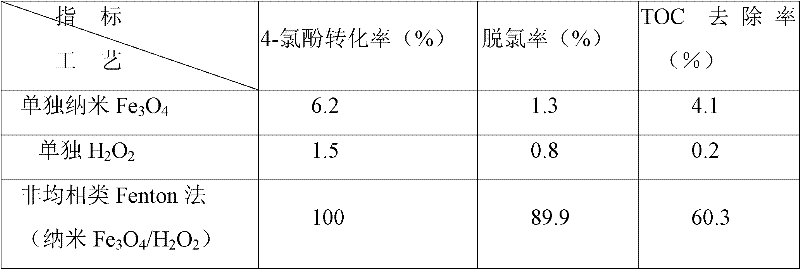A kind of method for treating chlorine-containing organic wastewater by heterogeneous fenton-like reaction
A technology of organic wastewater and reaction, applied in chemical instruments and methods, oxidized water/sewage treatment, chemical/physical processes, etc., can solve the problems of low utilization rate and high cost
- Summary
- Abstract
- Description
- Claims
- Application Information
AI Technical Summary
Problems solved by technology
Method used
Image
Examples
Embodiment 1
[0045] The preparation process of nano-zero-valent iron is as follows: Pre-add FeSO with a concentration of 4mM in a four-neck round bottom flask 4 ·7H 2 O solution 100mL, stirring and argon gas to make it in an anaerobic state, the concentration of 20mM KBH 4 100mL of the solution was dropped into a four-necked round-bottomed flask through a regulating valve, and kept stirring to make the solution in a uniformly mixed state. After 1.5 hours of reaction, the synthesized nano iron particles were precipitated, washed twice with deionized water, and dried in vacuum to obtain nano Fe 0 . Nano Fe 0 The morphology is regular spherical particles with a particle size of 80-150nm.
[0046] The experiment compared the heterogeneous Fenton method (while adding nano-Fe 0 And H 2 O 2 ), add nano Fe separately 0 And add H separately 2 O 2 The conversion rate, dechlorination rate and TOC removal rate of 4-chloro-3-methylphenol under the three methods.
[0047] Nano Fe 0 And H 2 O 2 In the combined...
Embodiment 2
[0056] The preparation process of magnetic nano-ferroferric oxide is as follows: prepare 100mL of 0.2M NaOH solution and place it in a four-neck round-bottomed flask in a constant temperature water bath at 80°C; stir and pass argon to make the round-bottomed flask in an oxygen-free state; Fe 2 (SO 4 ) 3 And FeSO 4 ·7H 2 100mL of O solution, of which Fe 2 (SO 4 ) 3 And FeSO 4 ·7H 2 The concentration of O is 0.02M and 0.01M respectively, and a certain amount of concentrated sulfuric acid is added to the solution to inhibit Fe 2+ The oxidation; this mixed solution is dropped into a four-neck round-bottom flask at a certain speed through a regulating valve, and reacts with the NaOH solution to generate nano-Fe 3 O 4 Particles, after 1.5h of reaction, the synthesized nano Fe 3 O 4 The particles are precipitated, washed twice with deionized water, and dried in vacuum to obtain nano-Fe 3 O 4 . Nano Fe 3 O 4 The morphology is regular spherical particles with an average particle size of 5...
Embodiment 3
[0067] The preparation process of nano-zero-valent iron is the same as in Example 1; the preparation process of the magnetic nano ferroferric oxide is the same as in Example 2.
[0068] Heterogeneous Fenton method was used to treat 4-chloro-3,5-dimethylphenol wastewater. The initial concentration of wastewater was 150mg / L, pH was not adjusted (pH 6.3), and 1.0g / L nano-Fe was added at the same time 0 / Fe 3 O 4 Mixture (of which Fe 0 With Fe 3 O 4 The mass ratio is 1:1) and 18mM H 2 O 2 , Place the reactor in a water bath shaker with a speed of 150 rpm and a temperature of 30°C. The treatment results are shown in Table 3.
[0069] Detection method: the same as in Example 1.
[0070] The results in Table 3 show that the heterogeneous Fenton method has a better effect on the treatment of 4-chloro-3,5-dimethylphenol wastewater. After 180 minutes of reaction, the conversion rate of 4-chloro-3,5-dimethylphenol is as high as 100%, the dechlorination rate and TOC removal rate are also high. ...
PUM
| Property | Measurement | Unit |
|---|---|---|
| Particle size | aaaaa | aaaaa |
| The average particle size | aaaaa | aaaaa |
Abstract
Description
Claims
Application Information
 Login to View More
Login to View More - R&D
- Intellectual Property
- Life Sciences
- Materials
- Tech Scout
- Unparalleled Data Quality
- Higher Quality Content
- 60% Fewer Hallucinations
Browse by: Latest US Patents, China's latest patents, Technical Efficacy Thesaurus, Application Domain, Technology Topic, Popular Technical Reports.
© 2025 PatSnap. All rights reserved.Legal|Privacy policy|Modern Slavery Act Transparency Statement|Sitemap|About US| Contact US: help@patsnap.com



